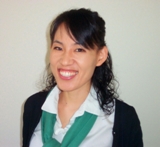|

Okim Kang,
Northern Arizona University,
Flagstaff, AZ, USA |
|

Shelley Staples, Northern Arizona University,
Flagstaff, AZ, USA |
|

Elizabeth Wittner, University of Virginia, Charlottesville,
VA, USA |
Although international teaching assistants (ITAs) are an
increasingly common presence at U.S. universities, many U.S.
undergraduates continue to perceive ITAs as unqualified to teach, in
part due to perceived problems with accent and comprehensibility. Such
evaluations have been shown to be based in part on student attitudes
rather than solely on objective assessments of proficiency; however,
they still have a real impact on students’ ability to understand ITAs
(Kang & Rubin, 2012). As a result, ITA coordinators and
researchers have begun to investigate ways to moderate students’
negative perceptions of ITAs. Positively impacting students’ perceptions
of ITAs, along with language and cultural training for the ITAs, is an
important aspect of improving communication within this community.
Recent research suggests that contact between undergraduates
and international students can have a positive impact on undergraduates’
perceptions of ITAs (Kang & Rubin, 2012). Contact between
members of opposing groups has been promoted as a mitigating approach,
starting with Allport’s (1954) Contact Hypothesis. That is, under the
right circumstances, contact can provide individuals with experiences
that do not fit their previous stereotypes about a group (Rubin
& Lannutti, 2001). First, the members should have equal status
in the group. Second, decisions should be made through the negotiation
of both parties. Group members should have a common goal to achieve.
Next, collaboration between the group members is essential. There should
be enough time for the interaction, and it should not be confounded by
other stresses. Potential for developing interpersonal relationships is
important as well. Participants should be seen as typical members of
their group. Finally, institutional support by a sanctioned authority is
an important factor in the successful impact of the intergroup contact.
Most studies, however, still lack specific details on how to
implement a contact program in higher education institutions. Therefore,
in this short report we introduce a language partner program that has
been implemented for both U.S. undergraduate students and ITAs as a part
of the contact series to enhance their communication. Then we briefly
report how undergraduate students’ perceptions changed regarding ITA
speech and teaching ability after the semester-long contact with
international partners. At the end, we conclude by offering suggestions
for further contact courses and implications for current practices in
ITA programs.
The Study
Thirty undergraduates (24 female, 6 male) from a midwestern
research university participated in a language partner program. They
were all native speakers of English, and most of them reported their
ethnicity as White. Thirty international partners also participated in
the study 19 Chinese, 6 Japanese, 3 Koreans, 1 Vietnamese, and 1
Indonesian. Undergraduate participants took two surveys (10 minutes
each): one at the beginning of the fall semester in 2011 and the other
at the end of the semester. The survey included ratings of the five ITA
speech samples and a background questionnaire. The rating scales
included accent, comprehensibility, and teaching quality of the
speakers. The speech samples were ITAs’ simulated instructional
presentations given in conjunction with required classes for ITAs who
failed to achieve a score exceeding 45 on the SPEAK test. The content of
each presentation focused on a concept from each presenter’s course of
study. After the completion of the posttest survey, online interviews
were administered in order to better understand participants’ experience
with the program and their change in attitude toward ITAs.
Language Partner Program
The language partner program in this study was connected with a
university-wide English for academic purposes (EAP) program serving
primarily matriculated graduate students and ITAs. Contact participants,
who volunteered to join the language partner program, interacted with
their international partners once a week for 8 weeks for 1 hour each
time. Participants and their international partners chose the time and
location for the meeting. They primarily chose their own topics for
discussion, but activities were suggested at five points in the
semester.
The five activities designed for 50-minute encounters were
developed both by modifying several previously created activities and
incorporating principles recommended in the literature (e.g., Kang
& Rubin, 2012). The activities focused on intercultural
communication issues. Each activity began with a discussion, had
opportunities for collaborative participation in reaching a goal, and
ended with reflection. For example, one activity focused on
ITA-undergraduate pairs sharing advice. Undergraduates shared their
experiences with the U.S. education system to help inform ITAs, and ITAs
shared their experience as successful students to help give advice to
undergraduates. The pairs then participated in role-plays in which they
had to switch roles with their partner (the undergraduate played the ITA
and the ITA played an undergraduate). The activity ended with a
reflection on what each member had learned from the experience of
playing a different role.
Discussion
The results indicate that the contact had a positive impact on
the outcome ratings (accent, comprehensibility, and teaching ability).
That is, at the posttest after the contact, undergraduate students
evaluated ITAs’ speech more positively, compared to their ratings at the
pretest. The qualitative comments suggest that participants gained a
deeper understanding, appreciation, and respect for ITAs and
international students through participation in the program. These
findings suggest that a well-structured contact program mitigates
undergraduates’ evaluations of ITA speech and instructional
competence.
The contact creates an environment where there can be a shift
in the culture of undergraduates as consumers. When undergraduate
students see their role as consumers, they have no motive to try to
accommodate speakers whose English is perceived as nonnative. The
language partner scenario practiced in this study can enable the
institution to promote ITAs as valued agents for learning. There is also
evidence that the undergraduates who participated in the program
believe it is their responsibility to share in the communicative burden
during interactions with international interlocutors (Lippi-Green,
2012).
Suggestions for Implementing a Language Partner Program
We saw that a structured intergroup contact experience between
ITAs and U.S. undergraduate students could yield a positive impact on
certain attitudinal responses. Accordingly, we would like to propose
some suggestions for implementing a contact program in higher education
institutions. First, we suggest that ITA programs should be housed in a
university-wide unit or partner with other institution-wide programs.
Because undergraduate students who voluntarily enroll in ITA-related
programs are likely not the ones who are most in need of this training
(Kang & Rubin, 2012), intergroup contact exercises may need to
be incorporated into institutionally supported learning community
programs such as orientation programs, international studies offices, or
global student councils.
Next, ITA programs should focus on cultural programs as well as
language training programs, and further emphasize an active involvement
of undergraduate students. Undergraduate students themselves should
take a leading role in various activities such as recruiting,
organizing, coordinating, and troubleshooting the cultural partners
program. This type of activity can be treated as an intercultural
internship for undergraduate students who have limited experience in
cultural diversity. Because the large burden of instruction is carried
by ITAs at many institutions in North America, this form of
student-directed movement could be helpful for improving student
learning outcomes across campus.
Finally, when both ITAs (or international students) and
undergraduate students meet together, they should be advised to work on
specific tasks. At the initial meeting, they can find out any specific
topics both partners would prefer. However, the gatherings should be
nonhierarchical so that both parties are given equal responsibility for
discussion content and idea exchanges. Eventually, activities that
promote the contact principles can be suggested to partners who are
meeting on their own or can provide the basis for interactions that are
arranged by program coordinators. Overall, we believe that this type of
contact activity can be a model of one approach to improving
undergraduates’ comprehension of ITAs, and for the broader goal of
enhancing students’ global citizenship without ever leaving their home campuses.
References
Allport, G. W. (1954). The nature of prejudice. Cambridge, MA: Addison-Wesley.
Kang, O., & Rubin, D. (2012). Inter-group contact
exercises as a tool for mitigating undergraduates’ attitudes toward
ITAs. Journal of Excellence in College Teaching, 23,
159–166.
Lippi-Green, R. (2012). English with an accent:
Language, ideology, and discrimination in the United States.
New York, NY: Routledge.
Rubin, D. L., & Lannutti, P. (2001). Frameworks for
assessing contact as a tool for reducing prejudice. In V. H. Milhouse,
M. K. Asante, & P. O. Nwosu (Eds.), Transcultural
realities: Interdisciplinary perspectives on cross-cultural
relations (pp. 313–326). Thousand Oaks, CA: Sage.
Okim Kang, PhD, is assistant professor of applied
linguistics at Northern Arizona University. Her research focuses on L2
pronunciation, language attitudes, oral proficiency assessment, and ITA
issues. She is the winner of Christopher Brumfit PhD Thesis 2009 Award
from Cambridge University Press and the Journal of Language
Teaching.
Shelley Staples is a PhD candidate in applied
linguistics at Northern Arizona University. She previously taught in the
EAP/ITA program at the University of Virginia. Her research interests
focus on issues relevant to ESP, including corpus-based analyses of
specialized registers of spoken discourse and native speaker perceptions
of international professionals.
Elizabeth Wittner is the academic director and ITA
Program coordinator at the Center for American English Language and
Culture at the University of Virginia. She has been involved in TESOL
for the past 25 years, but came to higher education and ITA training
about 12 years ago. Her interests include oral English, pedagogy, and
intercultural communication. She is the current chair-elect for the
ITAIS. |

